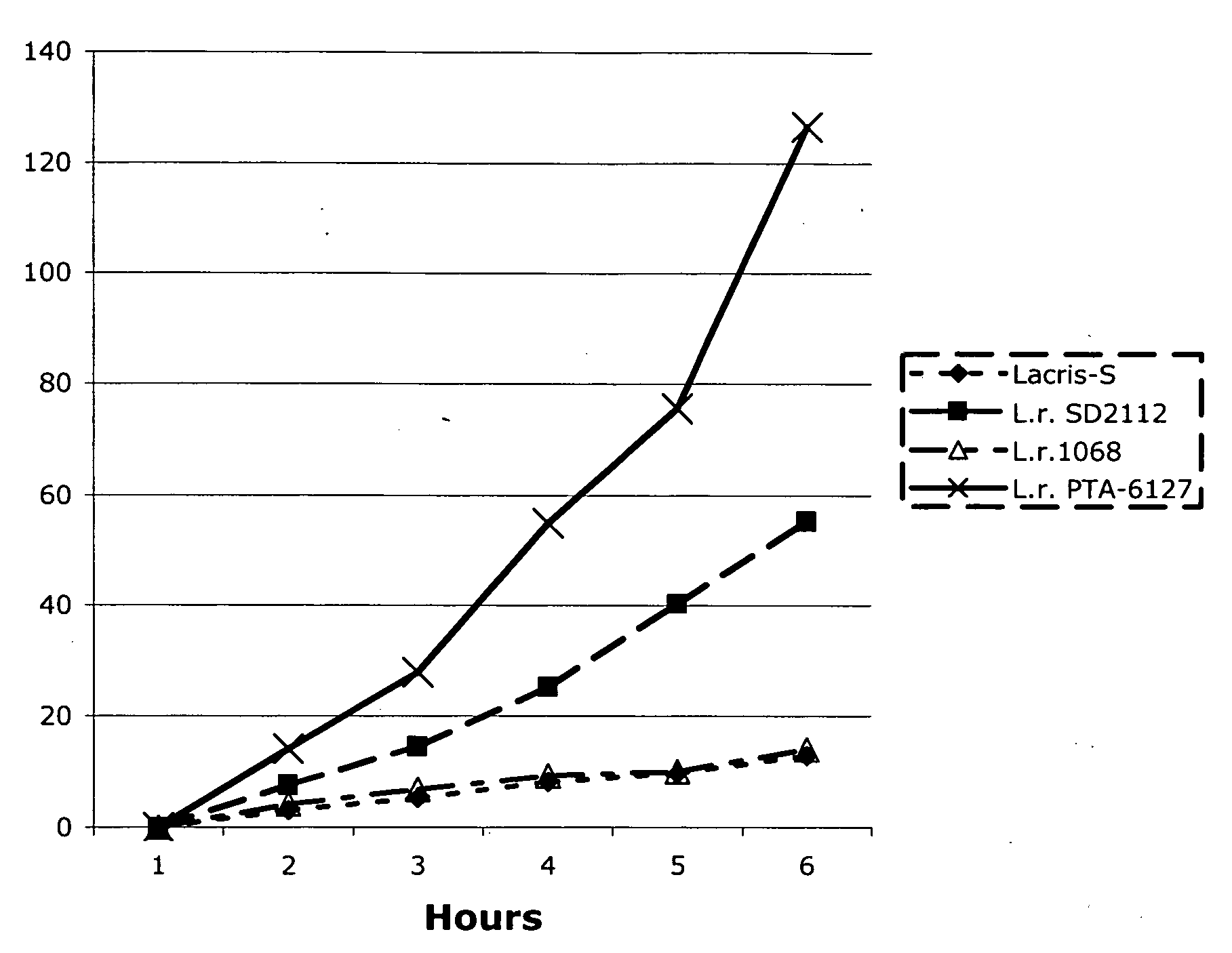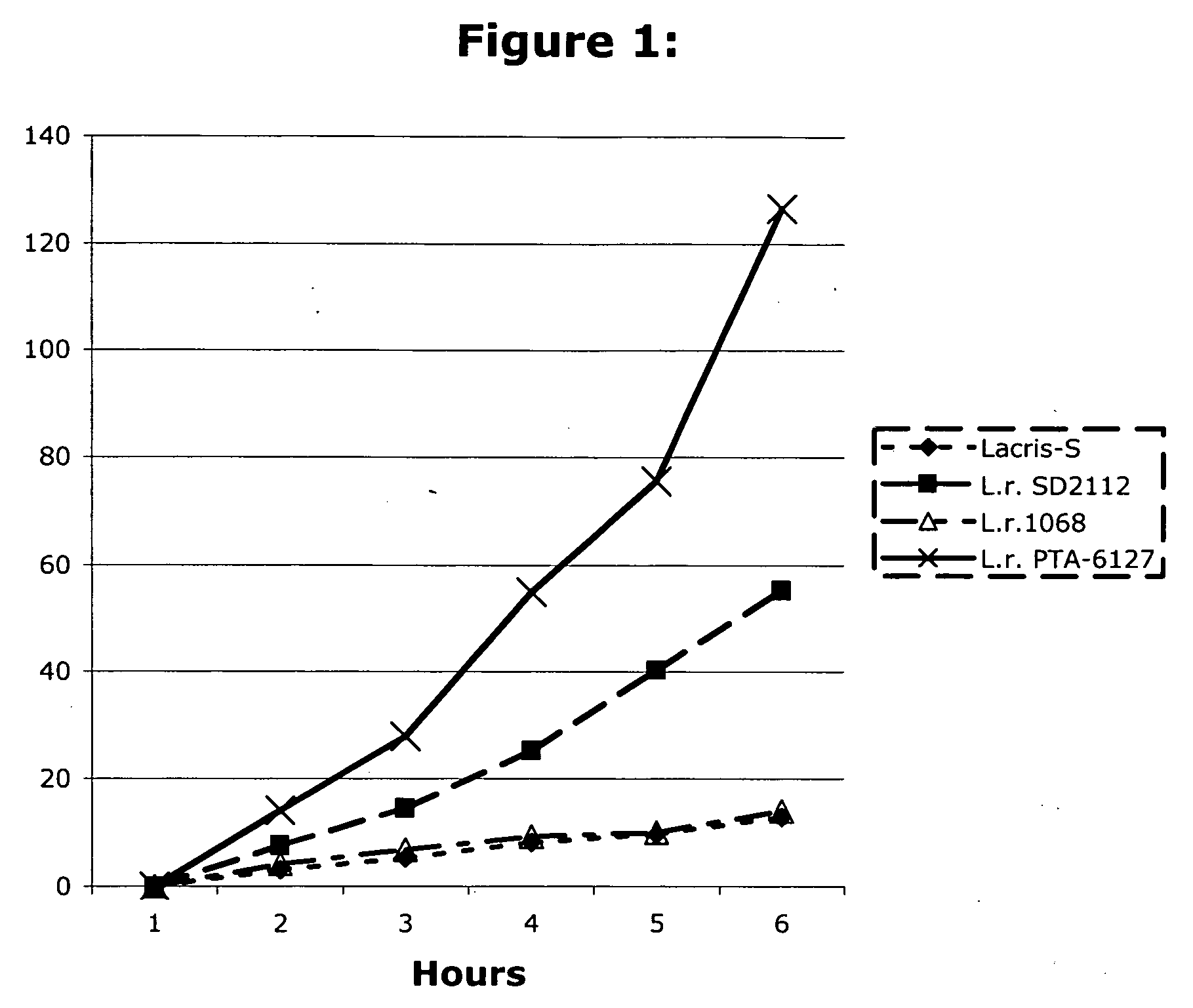Use of lactic acid bacteria for improving food lysine absorption of pet animals
a technology of lactic acid bacteria and food, which is applied in the field of selection and use of nonpathogenic, lysine uptake stimulating lactic acid bacteria strains, can solve the problems of unfavorable oxygen-requiring microorganisms, inability to completely compensate for deficiencies in the supply of indispensable amino acids, and high instability of lysine in intact proteins. , to achieve the effect of treating and prophylaxis of fur and claw quality
- Summary
- Abstract
- Description
- Claims
- Application Information
AI Technical Summary
Benefits of technology
Problems solved by technology
Method used
Image
Examples
example 1
Preparation of Cell Culture
[0036]Caco-2 cells (ATCC Number: HTB-37, Manassas, Va., USA) were cultured as described in (Thwaites et al., 1993a; 1993b). Cell monolayers were prepared by seeding at high density (4.4-5.0°-105 cells / cm2) onto 12 or 24.5 mm diameter tissue culture inserts [Transwell polycarbonate filters (Costar)]. Cell monolayers were maintained at 37° C. in a humidified atmosphere of 5% CO2 in air. Cell confluence was estimated by microscopy and determination of transepithelial resistance. Radiolabeled fluxes for lysine were performed 18-25 days after seeding and 18-24 hr after feeding.
example 2
Method for Selecting L. reuteri Strains for Intestinal Lysine Uptake
[0037]Caco-2 cells monolayers were washed (4 times in 500 ml of modified Krebs buffer (of composition (all mmol / l), NaCl 140, KCl 5.4 CaCl2 2.8, MgSO4 1.2, NaH2PO4 0.3, KH2PO4 0.3, HEPES 10, glucose 10 (pH to 7.4 at 37° C. with Tris base))) or Na+-free Krebs buffer where appropriate (as above but choline Cl− replacing NaCl and NaH2PO4 and placed in 6-wells plates (Life Technologies) containing 2 ml of prewarmed (37° C.) Na+-free Krebbs buffer. Aliquots of fresh Krebs buffer or Na+-free Krebbs buffer were placed in the chamber. Radiolabeled lysine ((3H) Amersham) was used at tracer concentrations (0.2 microCi / ml). Epithelial layers were then incubated with various LAB to be tested; Lactobacillus reuteri ATCC PTA-6127, Lactobacillus reuteri 1068, Lactobacillus reuteri SD2112 and Bacillus coagulans Lacris-S strain at the concentration of 7.0×107 cfu / ml for 6 hours at 37° C. 200 microL samples were taken every 60 minute...
example 3
Manufacturing of Feed Products Containing Selected Strain
[0038]In this example, L. reuteri “Shiny” (ATCC PTA-6127) is selected based on good growth characteristics in general and favorable results in the earlier mentioned selection in Example 2 in order to add the strain to a commercial product. The L. reuteri Shiny strain is grown and lyophilized, using standard methods for growing Lactobacillus in the industry.
[0039]A feed mixture is made up of corn, corn gluten, chicken and fish meal, salts, vitamins and minerals. The feed mixture is fed into a preconditioner and moistened. The moistened feed leaving the preconditioner is then fed into an extruder-cooker and gelatinized. The gelatinized matrix leaving the extruder is forced through a die and extruded. The extrudate leaving the die head is cut into pieces suitable for feeding to dogs, dried at about 140° C. for about 20 minutes, and cooled to form pellets. The water activity of the pellets is about 0.6.
[0040]The pellets are spraye...
PUM
| Property | Measurement | Unit |
|---|---|---|
| Acidity | aaaaa | aaaaa |
| Permeability | aaaaa | aaaaa |
| Strain point | aaaaa | aaaaa |
Abstract
Description
Claims
Application Information
 Login to View More
Login to View More - R&D
- Intellectual Property
- Life Sciences
- Materials
- Tech Scout
- Unparalleled Data Quality
- Higher Quality Content
- 60% Fewer Hallucinations
Browse by: Latest US Patents, China's latest patents, Technical Efficacy Thesaurus, Application Domain, Technology Topic, Popular Technical Reports.
© 2025 PatSnap. All rights reserved.Legal|Privacy policy|Modern Slavery Act Transparency Statement|Sitemap|About US| Contact US: help@patsnap.com


